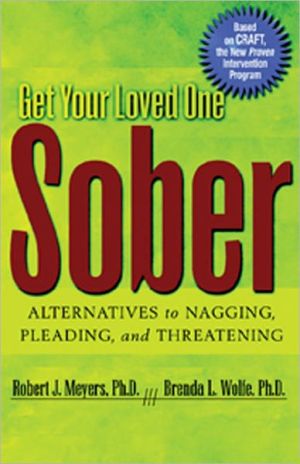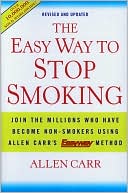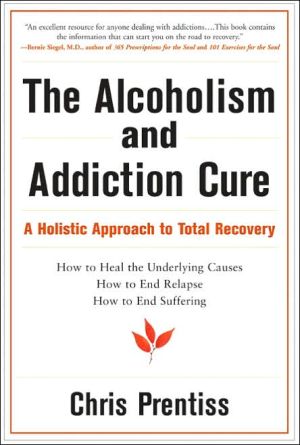Get Your Loved One Sober
Historically there have been few options available for individuals seeking help for treatment-resistant loved ones suffering from substance abuse.\ Coauthor Dr. Robert Meyers spent ten years developing a treatment program that helps Concerned Significant Others (CSOs) both improve the quality of their lives and to learn how to make treatment an attractive option for their partners who are substance abusers. Get Your Loved One Sober describes this multi-faceted program that uses supportive,...
Search in google:
Historically there have been few options available for individuals seeking help for treatment-resistant loved ones suffering from substance abuse.Coauthor Dr. Robert Meyers spent ten years developing a treatment program that helps Concerned Significant Others (CSOs) both improve the quality of their lives and to learn how to make treatment an attractive option for their partners who are substance abusers. Get Your Loved One Sober describes this multi-faceted program that uses supportive, non-confrontational methods to engage substance abusers into treatment. Called Community Reinforcement and Family Training (CRAFT), the program uses scientifically validated behavioral principles to reduce the loved one's substance use and to encourage him or her to seek treatment. Equally important, CRAFT also helps loved ones reduce personal stress and introduce meaningful, new sources of satisfaction into their life. Key Features CRAFT is more effective than other types of interventions. This breakthrough new system is sweeping the recovery field. This is its first introduction to the general public. Contains simple exercises readers can practice at their own pace, with no costly or heart-breaking interventions. Proven successful for numerous addictions, not just alcoholism. Author Highlights Robert J. Meyers, Ph.D., is an Associate Professor of Psychology at the University of New Mexico. He is also the Associate Director of the Clinical Research Branch of the Center on Alcoholism Substance Abuse and Addictions (CASAA). CASAA is internationally known for its excellence in substance abuse research and treatment development. Dr. Meyers has workedin the substance abuse field for over 27 years and has published several books and dozens of articles. Brenda L. Wolfe, Ph.D., is a Clinical Psychologist specializing in the treatment of Eating Disorders, Substance Abuse, and Post-Traumatic Stress. In addition to her busy private practice, Dr. Wolfe is involved in research collaborations at the University of New Mexico, serves as a corporate consultant for the development of psychologically based services, and is active in various professional organizations. Her books and articles have appeared in both the popular and professional press.
Can This Book Help You?\ If you live with or love someone who drinks or drugs too much, this book can help you. This book offers you a program that has been proven to help people whose lives are affected by a problem drinker, a drug user, or someone who does both. If you feel stuck in a hopeless, substance-ruled life, this book can help you. If you have ever called, or wanted to call, a crisis line, clinic, or hospital and said, "Help, my husband is drinking himself to death" or "Help,\ my kid stays out all night getting high, and I'm scared to death," this book can help. You will also find help here if alcohol or drugs are destroying your marriage or scaring your children. Whether you are the wife, husband, lover,\ parent, son, daughter, or friend of an alcoholic or drug user, this book offers you the tools both to help you help your loved one find the path to sobriety and to improve your own life.\ Throughout the book you will notice that we primarily illustrate our points with alcohol abusers. The program, however, has been proven to be effective with loved ones who abuse a wide variety of substances ranging from alcohol and marijuana to heroin and crack. Thus, you can effectively apply the program to your loved one regardless of the substance of abuse.\ If you have "tried everything" and nothing has worked, but you are not ready to give up, then you are in the right place. The scientifically validated program on which this book is based has been designed specifically for people who feel they have "tried it all." They have scolded,\ nagged, begged, bribed, detached, and tried a few tricks not fit to print. Just like you, they love their drinkers enough to keep trying and trying. What they have not done (and what we will teach you to do) is use that love to change the way they and their drinkers interact so that they spend less time feeling miserable and their loved ones discover the pleasure in being sober. From where we sit, that's an awfully good deal. We are confident that you will also find it to be so.\ Of course, we cannot guarantee that every single problem will be solved. What we can promise is that we will teach you skills to regain control of your life and to offer your drinker the best help available. In some cases, applying these skills does not result in complete abstinence and happily-ever-after—but in most cases, it does result in a better life for you and in sobriety for your drinker. The happily-ever-after is up to you and your loved one to create.\ \ To keep their discussion uncluttered, the authors primarily refer to drinkers for the rest of the book, rather than to drinkers and drug users. The material is equally applicable to both groups, although extra caution should be taken in cases where the user's lifestyle is centered around violence and criminal activity.\ \ from Chapter 1\ The Program\ The subtitle for this book, Alternatives to Nagging, Pleading,\ and Threatening, was chosen deliberately to emphasize that our program offers a positive alternative to the usual tactics people use to try to get their loved ones sober. If your loved one is still abusing alcohol or other drugs, in spite of your repeated efforts to get her to quit, then it is time to try something different. It is time to try the Alternatives.\ Learning the alternatives to nagging, pleading, and threatening is fairly straightforward. It will not take years of study for you to master these tools. You simply need to work your way through this program and give some serious thought to what you want and to the choices you make. Whether you do that quickly and decisively or slowly and deliberately is entirely up to you. Although the concepts are not complex, your life is, and change will happen at variable speeds despite your consistent efforts. Just keep in mind that if you do not try at all, it is likely nothing will change (at least not for the better). On the other hand, if you use the Alternatives, there is the very strong likelihood that your life will improve. Hence, dig in!\ The alternative to nagging, pleading, and threatening can be found in a simple system of behavior that has two goals and one central procedure.\ The goals are (1) to improve the quality of your life and (2) to make sobriety more attractive to your loved one than drinking. The central procedure is something we call "behavioral mapping." It is a way of figuring out how you and your drinker affect each other and how that pattern may be modified to achieve different results. For example, Ruth found it very upsetting that Paul would open a beer as soon as he came home from work every day. In fact, she found it so upsetting that each day she would bitterly complain about it, and they would fight. After mapping out their typical after-work scenario, Ruth realized that her complaints actually made it more likely that Paul would drink. He used the arguments as an excuse to justify his "needing" a relaxing drink.\ Her nagging also gave him a reason to "punish" her by drinking.\ Using the same Alternatives you will learn, Ruth was able to change her reaction to Paul's after-work beer. Further, by doing so, she eventually made it more enjoyable for him to skip the beer than to drink it. End of beer. End of complaints. End of arguments and punishment. Beginning of a better quality of life for Ruth and a shift toward sobriety for Paul.\ Sounds simple, doesn't it? Well it is both simple and difficult.\ The techniques are not difficult to learn. What can be difficult, however, is applying them in your current life. The way you and your loved one interact is a well-rehearsed routine born of your natural style, his natural style, the impact of alcohol on your loved one's brain and behavior, and the interaction of all of the above. If you think of the changes you want to achieve as a journey,\ you can draw a parallel between the simple lines on a road map and the techniques you will learn, and then draw a parallel between the actual roads you travel and the life context in which you implement them. Real roads, unlike their clean counterparts on a map, have potholes, detours, and traffic jams. Your life has hard-to-break habits, unforeseen crises, and just plain discouragement that you will need to overcome. However, just as you wouldn't give up a desirable journey simply because some of the roads are bumpy, you won't give up on changing life with your drinker just because it is not always easy. Change is almost never easy; but change for the better is always worth the effort.\ After months and years of nagging, pleading, and threatening your loved one,\ you are ready for a change.\ A Look Ahead\ As we have already said, there are two simple objectives to this program. One is to improve the quality of your life. That means not only getting your loved one to stop abusing alcohol, but more importantly, putting the sanity back into your own life regardless of whether she ever gives up drinking.\ That's right. It is time for your quality of life to become less dependent on whether your loved one is drunk or sober, in a good mood or bad, home or out. To this end, we will help you create a safety plan to ensure that regardless of your drinker's mood, you and those dependent on you do not become victims of violence. (We cover this in chapter 3.) On a happier note, chapter 4 offers you a glimpse of the future you will create. In other words, as you work your way through that chapter, you will figure out what you want your life to look like and begin to translate those dreams into attainable goals. Chapter 5 addresses the guilt that gets in the way of moving forward and helps you feel good about finally being in the driver's seat. Part of moving forward, of course,\ means rebuilding your emotional and social life. Chapter 6 shows you how.\ The objective of moving your loved one toward sobriety, believe it or not, is also helped by improving the quality of your life independent\ of his behavior. As your stress level decreases, you will be able to deal with your drinker in a calmer, less reactive manner, and your relationship will improve. This in turn will help you motivate your drinker toward sobriety. Unfortunately,\ your improved attitude, while necessary, is not sufficient to accomplish this second goal. Thus, we also give you a tool kit of techniques that are effective alternatives to nagging, pleading, and threatening. To begin with, the behavioral map we mentioned earlier forms the foundation of almost every strategy. Thus,\ an entire chapter is devoted to teaching you how to use this important technique.\ Chapter 2 will explain the behavioral map, provide lots of examples, show you how to use it in your own situations, and help you practice until you can map your interactions and be confident that you really are getting at what triggers your difficulties. Combining this awareness with the other techniques you learn will empower you in a way that nagging, pleading, and threatening never could.\ Moving on to these other techniques, you will find chapters devoted to disabling your enabling behaviors (chapter 7) as well as useful problem-solving and communication techniques (chapters 8 and 9). "Behavior Basics" (chapter 10) will equip you with the core tools of behavior change so that you can more easily modify your behavior and that of your drinker. (Lest you shudder at the thought of "modifying" anyone, stay calm. The section on page 7 called "A New Angle on Control" will explain what this really means. We are not pushing anything so devilish as mind control!)\ Chapter 11 is devoted exclusively to helping you select and support the best treatment approach for your loved one. Chances are you have been down the treatment road before—telling your drinker that treatment will help,\ begging her to consider it, even getting an agreement to try it, only to have your drinker not keep the appointment or drop out after only one or two visits.\ In fact, the unhappy reality is that the majority of drinkers who enter treatment seldom remain for more than one or two sessions. However, individuals whose partners, parents, children, and lovers have learned the Alternatives\ stay in treatment six or seven times as long as other drinkers do (Ellis et al. 1992). We attribute this to the fact that our clients learn how to suggest and how to support treatment. There is more to successfully engaging someone in treatment than guilting or goading this person into it (as you well know).\ We will teach you how. You will also learn what to do to make staying in treatment as attractive for your loved one as possible.\ Finally, chapter 12 addresses the important issues of relapse prevention and what happens after you have done everything you can. As you move through this journey of change, you will experience successes and face obstacles,\ some minor, others not. However, one of the key advantages of the Alternatives\ approach is that it prepares you to deal with obstacles, potholes, detours—whatever falls in your path. Thus, difficulties become opportunities for you to gain control over your life. Ultimately, whether or not your drinker achieves lasting sobriety, your journey with us will give you the skills and tools to enhance your own quality of life. Hence, in a best-case scenario, the two of you will achieve peace together and worst-case scenario is that you will have done everything possible and be able to move on and take care of your own life. In either case,\ your future looks brighter.\ About Change\ As you read this book, keep in mind one important truth. Change is not an event. It is a process—a slow process. No matter what behavior you want to change—a nail-biting habit, overeating, or how you relate to someone—it does not happen in one big jump. Making change is no different than taking a long car trip. You may decide on Monday morning to drive from New York to Los Angeles, but it will take longer than the moment of decision to get you there. You need to pack your bags, figure out what roads to follow,\ and so on. What's more, once you start driving, you will find that some of the roads you had planned to travel are closed or in poor repair. You will need to find detours, tolerate potholes, and otherwise adjust your plans as you go. You will also find that if you drive for shorter rather than longer periods each day, the trip will be more enjoyable, and you will feel more rested and in control. The same goes for your change journey.\ The improvements you are after will take time and are best achieved in small steps with careful planning. Given how long you have already lived with your drinker under the present circumstances, you can tolerate it a little longer as you make small, controllable changes. Rather than whipping through this book and making a mile-long list of things to "fix," work through the Alternatives with the plan of making one small change at a time. As these changes begin to feel natural, go back and add more. What you learn here is yours forever, so you need not hurry up and get through them quickly! Take your time, go slow, and enjoy the knowledge that you are on a life-enhancing journey.\ Keep the journey in mind as you move forward. When things don't go smoothly, remind yourself that every road trip has its snags. A highway detour between Albuquerque and Phoenix would not send you scurrying back to New York,\ so don't give up on your hopes for your drinker just because one or two or more attempts at change hit a wall. Each time you try a new technique and it does not work, sit down and think through what happened. Review your original plan, review what you did, get a clear picture of how your drinker responded,\ and think about how you might improve your approach. Use the same motivated problem-solving skills you would use if your highway of choice had a detour and you needed an alternate road to Los Angeles. These detours might be a nuisance,\ but they are a natural part of the journey. Expect them and you will master them.\ \ ¬2004. All rights reserved. Reprinted from Get Your Loved One Sober by Robert J. Meyers Ph.D., Brenda L. Wolfe, Ph.D. No part of this publication may be reproduced, stored in a retrieval system or transmitted in any form or by any means, without the written permission of the publisher.\ Publisher: Hazelden, Center City, MN 55012-0176.








